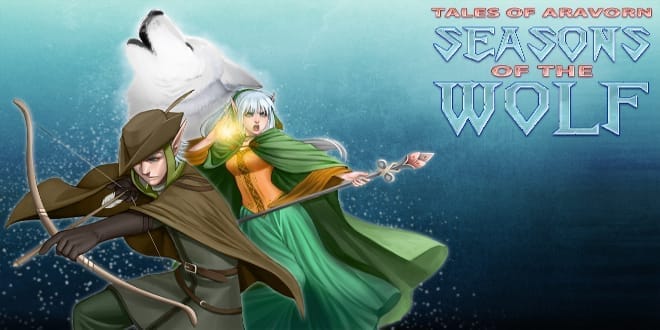We first looked at Tales of Aravorn Seasons of the Wolf back in November as a preview in To The Green, and while it hasn’t made it onto Steam yet, it will be there in early 2015 as it has been greenlit. Additionally since then, it’s been released and we’ve had a chance to sit down and play it all the way through, so now you can get our thoughts on the full game.
Tales of Aravorn Seasons of the Wolf - Structure, and Style
Seasons of the Wolf is a character and story-driven RPG developed by Winter Wolves, who are best known for their work in Visual Novels. While Seasons of the Wolf is not a Visual Novel, some elements in storytelling style do come over, as does the focus on story and characters. Seasons of the Wolf is structured into 4 chapters, each representing a season and taking place in a different location. The story is different than many other story driven games as it is not a grand epic or such, but instead a lower key story about the characters and their journey. There’s still plenty of excitement, but if you are expecting an evil to doom the world or a grand war, this isn't that type of story.
Tales of Aravorn Seasons of the Wolf - Story
The story focuses on the cast, which is introduced over the first two seasons of the game. The first season, Winter, takes place in the sleepy snowy north of Ninim, the home village of our protagonists, the snow elf twins Shea and Althea. To begin, you choose one of the two to be the primary protagonist and that you control directly.The only difference resulting from this choice is what romances are open to you as you play.
Shea and Althea live outside the village as their father was outcast for an unknown reason. They survive learning to trap animals, hunt and selling the pelts in the town – as the village does allow them to enter despite their father's banishment. Here we get a bit of a look into Shea and Althea’s life even if we aren’t in Ninim very long, as we see the way the villagers treat them, and are introduced to their friend Vaelis. A former mercenary Vaelis has traveled a lot, and early on he serves as a worldly mentor to the young and naive twins.
As events unfold, things get out of the twins' control when a trading caravan from the desert city of Dingirra arrives via a magic portal. A series of unfortunate events unfold including snow, a wolf, and a slave (don’t ask), leading to the capture of the lead twin by the Dingirrians. Vaelis and the uncaptured twin attempt a daring rescue, which ends with them all captured, and sent to Dingirra.
I am attempting to keep this relatively spoiler free – these are all things in the first few hours in the demo that you can play and in Dingirra the game really begins to open up. You meet the rest of the cast, there’s more options to choose from, and places to explore. There’s the warrior nomad Krimm, the cowardly illusionist Riley, the bard/scholar Jariel, the assassin Chalassa, and the crazy warlock Rowinda who all join in throughout the chapter.
Tales of Aravorn Seasons of the Wolf - Characters, Themes and Classes
For the most part these characters are well fleshed out and while they have a surface appearance there is more underneath that. Deceit is a major theme of the story, and sometimes that’s intentional – and sometimes it’s not. It would spoil some of the well written character stories here to give too many details – but the one character I would critique some is Rowinda. While she was clearly there for comic relief, her character felt more one dimensional, though some of that may be because I didn't explore her story more. However, it's a minor thing and she is often in the background and doesn't force her way into things.
The theme of deceit is well handled in the game – it’s not banged over your head or anything. Instead, like many things in real life, you find out that what you thought you knew wasn't quite true in many cases. Sometimes it’s a lie, sometimes it’s a misunderstanding, and sometimes it’s just a simple miscommunication. All these things can lead to deceit, and the story here does it well on that personal level about the characters and what is going on around you.
Each character in the game has their own unique class, with its own skill set. Additionally, a set of 9 traits is universally available to all characters that they can take instead of a skill at a level up. You get one of those every two levels up till level 6 where it becomes once every three levels. There are also 6 attributes that you level up – constitution, will, strength, skill, agility, and arcane.
The classes generally fit into one of three types – mage, fighter, or thief. The mages work best from the backlines always and their skills are typically magical spells and such. They do elemental damage – often for high damage at a target or good damage at many - and all use staff type weapons. Fighters are in the front line, typically have weak ranged options (or none at all in the case of Krimm), and use the stagger mechanic to get their best damage. Thieves are midline – able to go in either the front or back with good ranged and decent melee. They're special as they can use items like bombs or potions against enemies.
Tales of Aravorn Seasons of the Wolf - Mechanics
While each character's skill list is unique, it is a bit sad to say that they are lacking somewhat in diversity. Mages for example will end up with 3-4 skills doing more or less the same thing, with the only differences being the elemental type and condition it inflicts. There are similar repeats in other characters as well – such as the hunter (one of the options for the twins classes) having 4 skills that do 150% damage to a staggered target, which does elemental damage (depending on the skill), and an appropriate condition.
That does lead, especially later on, to the skill lists feeling a bit too small, and on normal at least the elemental differences were little most of the time. I can imagine that its possible on harder difficulties for the battlefield elemental resistances and enemy resistances to matter more, making the difference in which to use more important.
The combat in the game is relatively simple, using a turn based system that puts a delay on how long until you act based on what you do and your agility. It works pretty well with front targets being easier to damage protecting the back ones who can only be hit by ranged attacks typically. It moves quickly with a simple click and select interface and shows you the damage dealt while providing some tactical depth to consider.
The isometric maps in the game are where you can explore and look around. These have different areas where things happen, such as finding or working on quests, going to shops, or other locations. This gives a sense of exploration and interaction with the area around you, and unlocks some of the sidequests depending on where you go.Each season has a number of sidequests you can stumble upon and resolve or not as you choose – sometimes with different options. There aren’t a huge number of them but enough to give variety, and they give some different enemies and places to visit.
Tales of Aravorn Seasons of the Wolf - Final Details
One of the things the game does well is mix this type of play with the narrative, using flashbacks, (which in keeping with deceit may or may not be true) to tell the backgrounds of the other characters you meet. This lets you experience them at lower power levels than when you got them and follows the old story telling axiom – show don’t tell. Playing these background stories helps you know the characters better and provides a nice break in the gameplay by changing what power level the character is at, the skills available, the goals, and the group. They also have some impact, giving a special item that is associated with the character and the backstory if you are successful in getting through it.
The visuals for Seasons of the Wolf are nice but not stunning. The backgrounds look good, the isometric maps give a good feel on the locations and the enemies have some diversity. The different characters each have a distinct look and several outfits depending on location which works well. The world is well constructed both in writing and visually. The writing helps give a sense of where you are , and the world on a whole without the normal fantasy crutch of a world map. The visuals give each region a distinct look, but maintain a similar style to tie it in together.
The Verdict
On the whole, I enjoyed Seasons of the Wolf. I think that its focus on the adventures of a group of friends who forge bonds in circumstances over a period of time is nice and different from the constant type of epic fantasy we often see. It’s well written, has interesting characters and its combat more or less works, though some more diversity in skills would have been welcome. The combat isn't very hard, on normal at least, so if you want a challenge I suggest turning up the difficulty.
TechRaptor reviewed Tales of Aravorn Seasons of the Wolf on PC via Steam with a copy purchased by the reveiwer. It is also available on iOS and Android. This review was originally published on 01-06-2015. While care has been taken to update the piece to reflect our modern style guidelines, some of the information may be out of date. We've left pieces like this as they were to reflect the original authors' opinions and for historical context.
Review Summary
Have a tip, or want to point out something we missed? Leave a Comment or e-mail us at tips@techraptor.net













